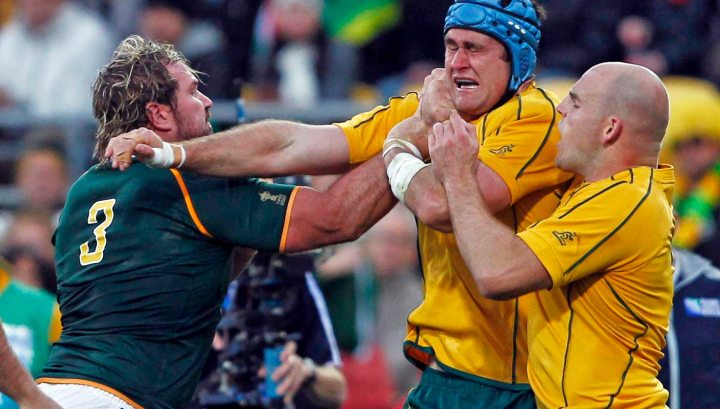Sport
Rugby: Tightheads at a loose end

The tight five is characteristically the place where the players are held together by bandages and gauze, such is the high-impact workload they have to shoulder in rugby seasons that are just getting longer and harder. But there’s one man in the Springbok pack who has been particularly burdened with a massive workload, and that is tighthead prop Jannie du Plessis. By KEN BORLAND.
The 30-year-old played in every SuperRugby match last year and in all 16 games for the Sharks this year, as well as every Test in 2012 and all three in 2013 thus far. But Du Plessis, a qualified medical doctor, says he’s relishing the challenge.
“I hope I become like leather: you know, the more you use it, the tougher and better it becomes. I don’t want to tempt fate and say I’m playing so much that I’m going to break down. I want to play 40 games a year for the next five years,” Du Plessis said after the Springboks’ training session in Fourways on Wednesday.
While the scrummaging skills and experience of the Bethlehem-born Du Plessis are invaluable in the crucial tighthead position – many ex-forwards say it’s the first position that should be chosen in a team – the other reason for why the Grey College-product is hogging the number three jersey is the lack of depth in his position in the country.
The current Springbok squad has five props in it and Du Plessis is the only one who can be regarded as a specialist tighthead, the foundation of a solid scrum.
The Springbok brains trust have identified Coenie Oosthuizen, the Cheetahs loosehead, as the next best tighthead in the land and coach Heyneke Meyer said the lack of depth has left him little choice but to develop the 24-year-old as the next choice number three for the 2015 World Cup.
“I truly believe we are in trouble with tightheads in South Africa,” Meyer said. “If you look at it, most of the guys are injured and at one stage we had the best tightheads in the world, but now there are a lot of inexperienced guys playing there.
“We feel Coenie is the second tighthead in the squad and we need to give him some game time. A tighthead is like great wine, it only gets better with time. Coenie is only 24 and we need someone who is the next tighthead who has time to develop and will be there for a long time.
“If Coenie doesn’t play there in Test match rugby, he won’t be right for the next World Cup. With Gurthro Steenkamp and Trevor Nyakane, they are great impact players, and we have a lot of looseheads with Beast as well. But we’re under pressure on the tighthead side,” Meyer said.
But there is also a lot of anti-Coenie-at-tighthead feeling around rugby circles, with many wondering why Cheetahs number three Lourens Adriaanse, an unused member of the Springbok squad in June, or impressive Sharks youngster Wiehahn Herbst aren’t given a chance.
Tighthead prop is a specialist position, like hooker or scrumhalf, and what Meyer is doing is a bit like trying to convert your second-choice outside centre into a scrumhalf just because he’s a great player. Coaches have to make tough decisions and, however brilliant Oosthuizen is and however much depth there is at loosehead, you can only have two in a match-day squad. Trying to turn a loosehead into a tighthead is fraught with danger, as we saw with previous coach Peter de Villiers’ unsuccessful attempts with John Smit.
Although Oosthuizen is an ox of a man – weighing 125kg and standing 1.83m – tighthead is a highly technical position where size and strength are not enough on their own.
Ask Jannie du Plessis himself.
“It is really flipping difficult to change from loosehead to tighthead, ask the looseheads who’ve tried. It’s a completely different position with a different set of skills. But I hope Coenie does well in the position, he’s done well enough when he has come on at tighthead, so then everyone won’t make such a big thing about it and me playing every game,” Du Plessis said.
The other problem with Oosthuizen playing tighthead is that he will be stuck in the scrum for longer and the Springboks stand to dilute two of his major weapons – his exceptional ability in carrying the ball and the pressure he brings to the breakdown.
And Oosthuizen’s switch is happening at a time of great uncertainty amongst front-rankers with the new scrum rules coming into effect for the Rugby Championship.
After protests over the number of collapsed scrums, the International Rugby Board [IRB] have introduced new calls governing the engagement. The new sequence is “crouch, bind, set”, requiring the props to bind before the scrum sets.
But the IRB, in their wisdom, have introduced the new protocol at Test level as well, without trialling it first in SuperRugby. So the top players in the Southern Hemisphere are all going into a crucial part of the game, for which match-swinging penalties are often given, blind, without any competitive experience of the changes.
“The scrums are an uncertainty for us. You have to play the cards that are dealt you, but the situation is that this is the first time in a Test series where we play the new rules. This year we are going straight into the new rules and we don’t know what to expect,” Meyer admitted.
Du Plessis, who has seen most things in the dark and dingy world of scrums, thinks even these new rules might not last.
“Normally you have a few games to get used to new laws, like they did with the ELVs. But the challenge now is to adapt right away. It might be a shambles and then they change it again.
“Since I started playing, this will be the sixth or seventh change to the scrum laws, so they are definitely chopping and changing and maybe they are scratching a place where it’s not itching… ” Du Plessis said.
The major difference that front-rankers will experience, with the “hit” taken out of the equation, is that scrums are going to last much longer now, according to Du Plessis.
“It’s going to be a big change. In the past you relied on speed because the gap between the front rows was big. Now because you’re binding first, you are much closer together and you can’t rely on speed.
“Scrums are going to be about generating more power and they will last much longer, so we’ll have to work harder. It won’t be so much about power and speed and more about endurance.
“They’ve said the scrum has to be steady now and they’re going to force scrumhalves to put the ball in straight, but it sounds like election promises to me: we hear that every year,” Du Plessis said. DM
Photo: South Africa Springboks’ Jannie Du Plessis (L) tussles with Australia Wallabies captain James Horwill (C) and Stephen Moore during their Rugby World Cup quarter-final match at Wellington Regional Stadium October 9, 2011. REUTERS/Marcos Brindicci



















 Become an Insider
Become an Insider